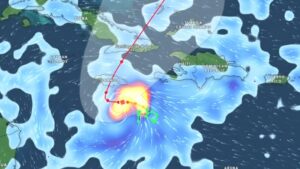
In a groundbreaking achievement for quantum technology, researchers at Northwestern University successfully teleported a quantum state of light through more than 30 kilometers (approximately 18 miles) of fiber optic cable in 2024. This remarkable feat was accomplished amidst the usual torrent of internet traffic, a challenge that once seemed insurmountable.
The demonstration, led by computing engineer Prem Kumar, marks a significant milestone in the pursuit of a quantum-connected network. While it may not lead to beaming individuals to work or accelerating video downloads, the successful teleportation of quantum states through existing infrastructure could pave the way for enhanced encryption, advanced computing, and improved sensing technologies.
A New Era for Quantum Communications
“This is incredibly exciting because nobody thought it was possible,” stated Kumar, emphasizing the importance of this research. The team’s work illustrates a potential pathway toward integrating next-generation quantum and classical networks utilizing a unified fiber optic infrastructure. Kumar noted, “It opens the door to pushing quantum communications to the next level.”
Teleportation, while reminiscent of science fiction concepts like the Star Trek transport system, entails transferring the quantum possibilities of an object from one location to another. This process requires the careful destruction of the original object, thereby forcing a similar balance of possibilities onto another object at the destination. Despite the instantaneous measurement of the two objects, entangling their quantum identities necessitates the transmission of information between the two points.
As quantum states exist in a delicate balance of probability, they can quickly lose their coherence through interactions with environmental factors. The challenge of maintaining a quantum state while transmitting it through optical fibers laden with everyday internet traffic—such as bank transactions and video streams—adds complexity to the task.
Innovative Techniques to Preserve Quantum States
To safeguard the integrity of their photon against a staggering 400 gigabits per second of internet traffic, the research team employed a combination of techniques designed to minimize scattering and interference. “We carefully studied how light is scattered and placed our photons at a judicial point where that scattering mechanism is minimized,” explained Kumar. This meticulous approach allowed the researchers to conduct quantum communication without interference from classical data streams.
While previous research had successfully simulated the transmission of quantum information alongside classical data, Kumar’s team is the first to achieve actual teleportation of a quantum state while concurrently streaming real internet traffic. Their findings suggest that the emergence of a quantum internet is not only possible but inevitable, offering computing engineers new tools for monitoring, measuring, and encrypting information like never before.
Kumar further remarked on the implications of their research, stating, “Quantum teleportation has the ability to provide quantum connectivity securely between geographically distant nodes.” He challenged the assumption that specialized infrastructure would be necessary for quantum communications. “If we choose the wavelengths properly, we won’t have to build new infrastructure. Classical communications and quantum communications can coexist.”
This pivotal research has been published in Optica, contributing to the expanding knowledge and understanding of quantum technologies and their potential applications in future computing environments.







